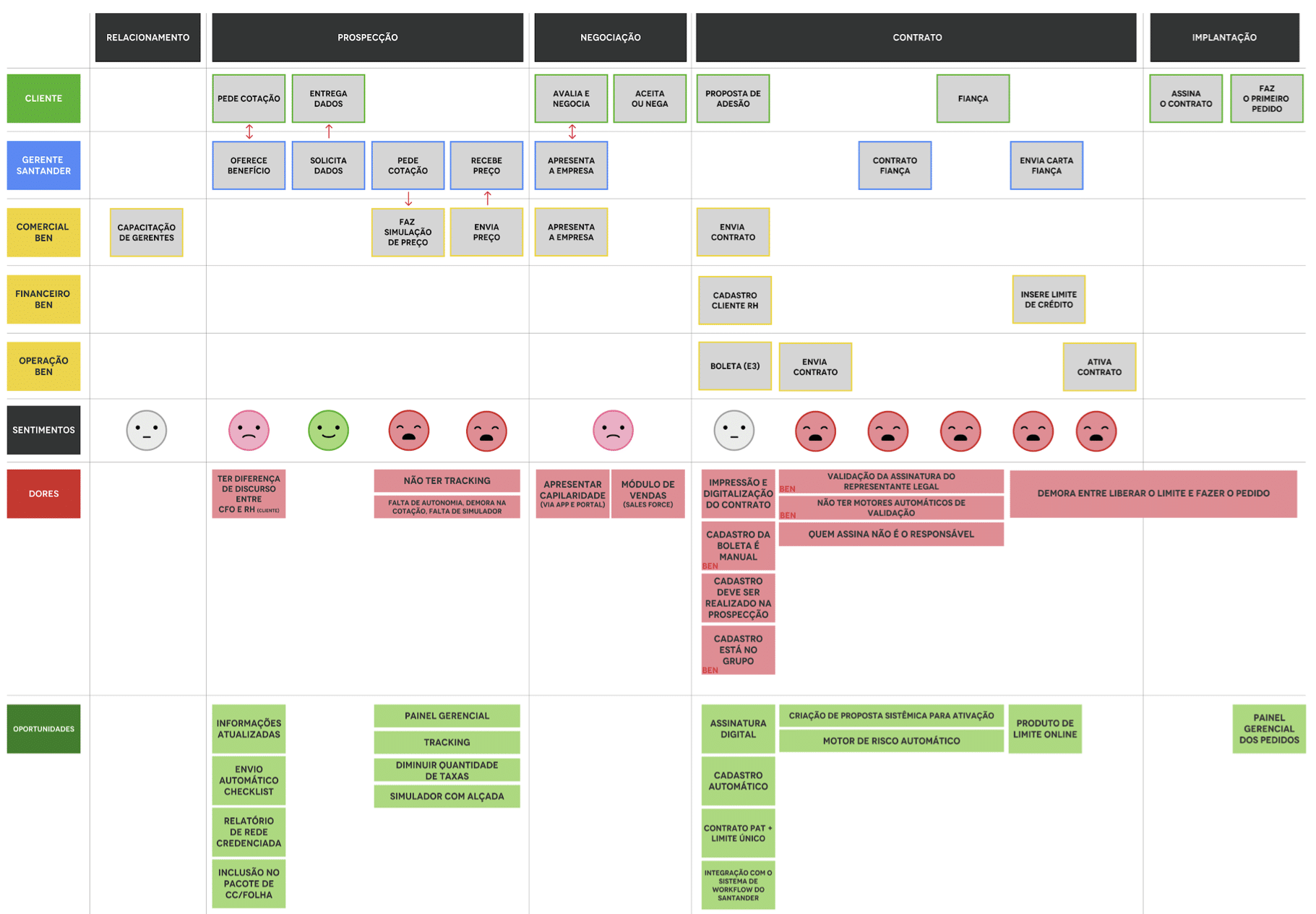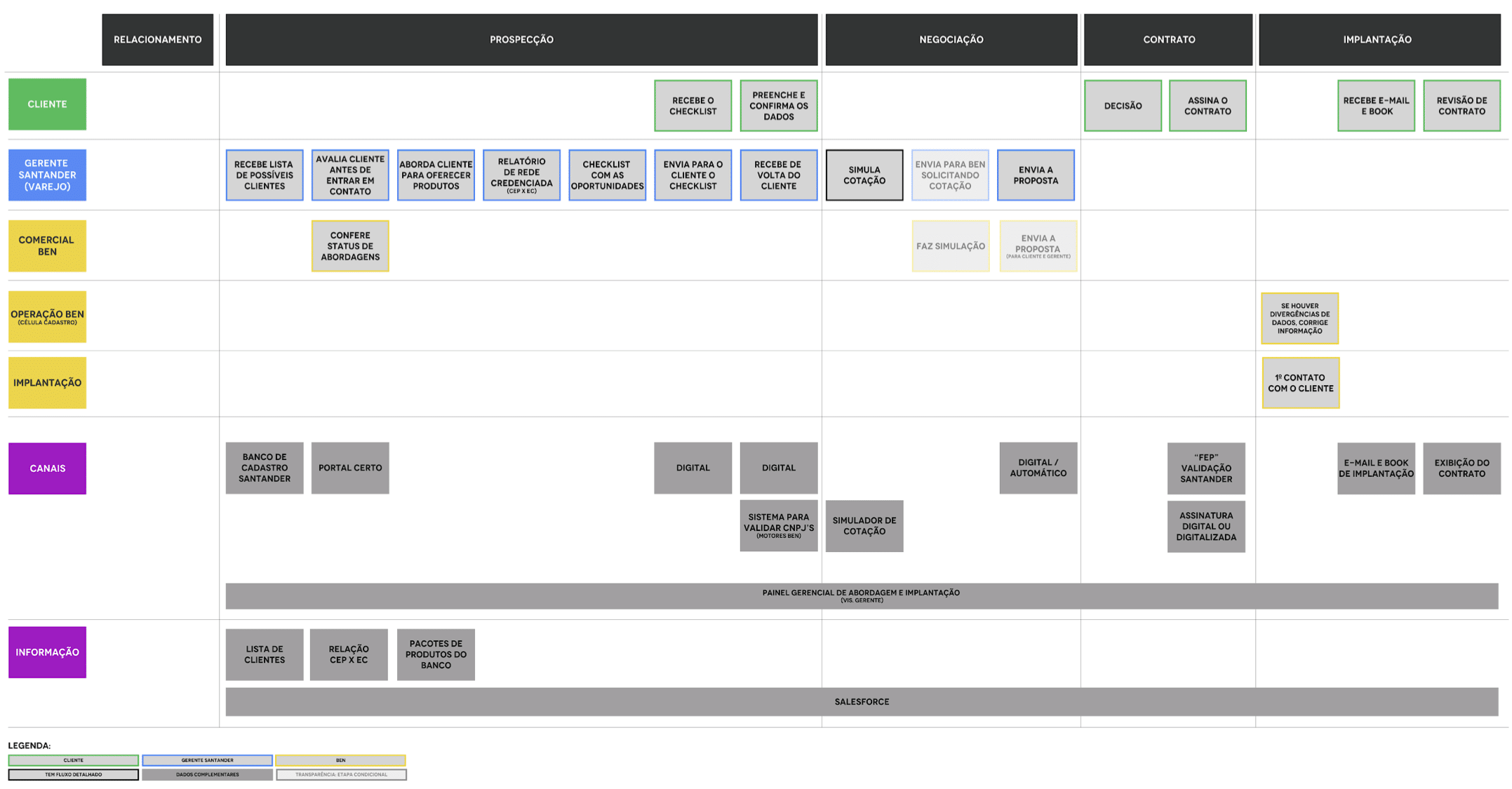Redefining the Sales Journey for Benefits Products
How automation and simplification of the sales process eliminated customer and team frustrations, increasing sales by 12% and reducing onboarding time by 25%.
- Company
Ben Visa Vale, a startup from the Santander Group
- Type of project
Service Design
- duration
3 years (Jan 2016 – Dec 2018)
- ResultS
+12% increase in sales
-25% reduction in client onboarding time
Structured a scalable roadmap
Context
Ben Visa, part of the Santander Group, is a startup focused on corporate benefits that faced challenges in keeping up with its ambitious growth goals. Recognizing the need to realign priorities and accelerate results, the GPM brought me in to diagnose the situation and establish a clear strategic plan.
With a lean design team—three designers and one researcher—we planned an approach focused on prioritizing high-impact solutions, aligning operational efficiency with significant improvements in the customer experience.
- My Role
As Head of UX, I led the project from discovery to implementation. Managing the design team and collaborating with product, engineering, and sales teams, I ensured strategic alignment, prioritizing fast and scalable results. I facilitated workshops, led prototyping, and validated solutions to drive meaningful impact.
Problem
Ben, a startup within the Santander Group, struggled to scale its operations due to a manual, slow, and non-integrated sales process involving multiple stakeholders and disparate systems.
These inefficiencies jeopardized the company’s goal of reaching 445 HR clients and R$ 88 million in annual revenue.
From an organizational perspective, the lack of integration between platforms and reliance on manual workflows increased costs and made it harder to adapt to military regulations.
User Pain Points
Business Pain Points
Solution Delivered
The solution focused on a complete redesign of the sales journey, leveraging agile methodologies and Design Thinking to reduce friction and integrate processes. The key outcomes included:
Complete Sales Journey Redesign
Simplified bureaucratic processes with clearer and more integrated workflows.
Developed a unified portal to manage everything from prospecting to onboarding.
System Integration & Automation
Created a centralized platform, eliminating fragmented systems and manual steps.
Established direct integration between Ben and the bank’s systems, streamlining client onboarding.
Sales Team Enablement & Incentives
Developed clear and instructional support materials for bank managers.
Implemented proposal simulators, reducing negotiation time.
Scalable Roadmap Structure
Aligned priorities with the company’s growth goals, focusing on short- and mid-term scalability.
Process
and Methodology
Understanding the Scenario
At the start of the project, the product and sales teams had already conducted initial research and started exploring solutions. However, this work was insufficient and disorganized, leaving teams uncertain about how to move forward.
The design team’s role was crucial in “bringing order to chaos”—leveraging existing insights, defining the real problem, and structuring a more efficient and strategic process.
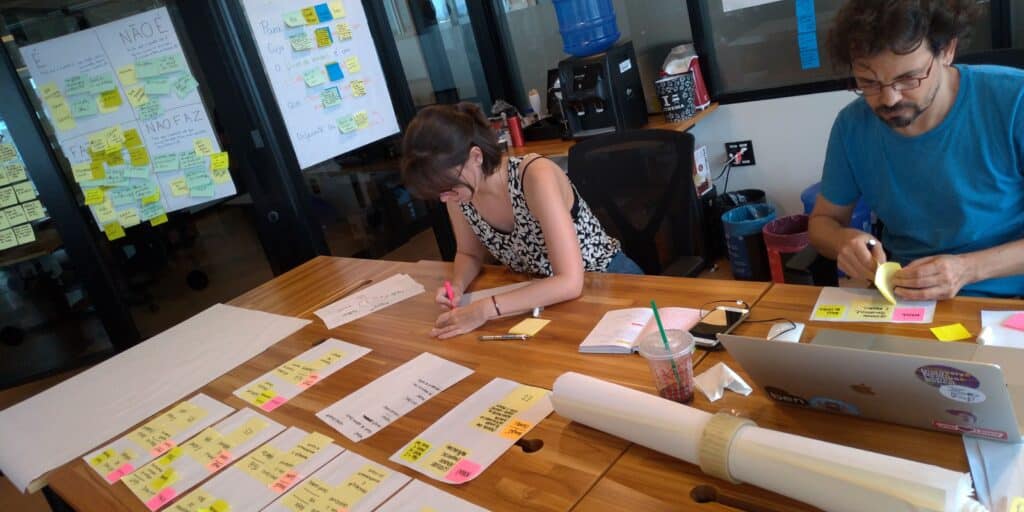
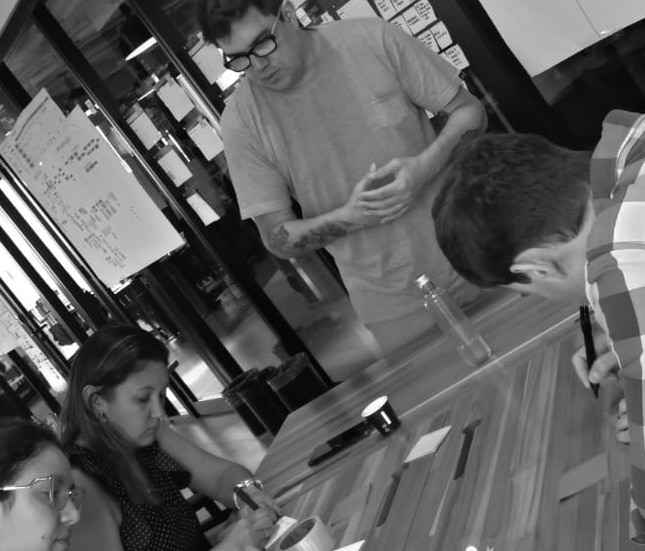
Building on Previous Discovery
This initial phase was challenging as we had to extract value from previous research and reorganize insights. The product and sales teams struggled to use the data strategically.
As a facilitator, I guided the design team to optimize the available data, prioritize effectively, and bring clarity to the process. Our structured approach earned positive feedback from GPM, highlighting how design played a key role in aligning strategy and execution.
This ability to organize and maximize existing work is not always associated with design teams, but it was central to this project’s success.
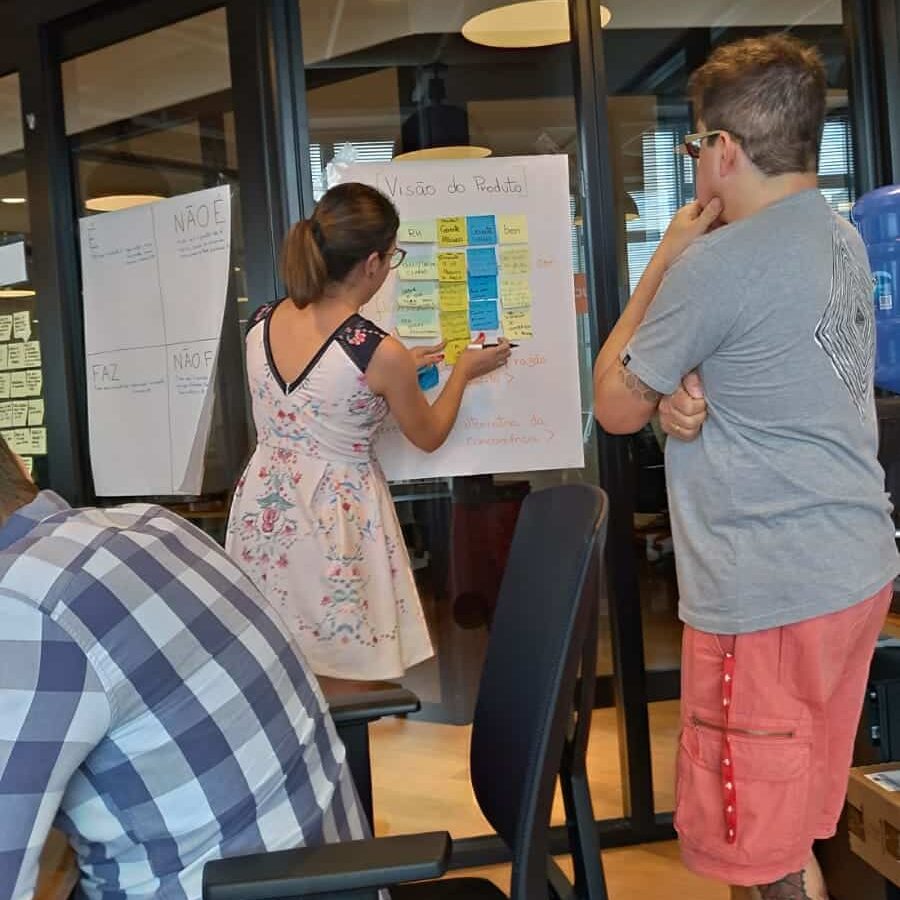
Alignment & Defining Next Steps
I conducted an initial alignment with key stakeholders—including the Product Director, Sales Manager, and GPM—to clarify expectations and objectives. Using the “Is, Is Not, Does, Does Not Do” canvas, we redefined the vision for the sales journey and the value it needed to deliver.
This helped guide the design team in identifying gaps from previous research and establishing a clear roadmap for the discovery phase.
It became evident that we needed to structure mapping sessions for the current sales journey and its pain points, followed by co-creation workshops to design the solution. To ensure a diverse and engaged approach, we involved sales, customer service, product, support, and onboarding teams.
Key Learnings:
- Operational bottlenecks and customer frustrations stemmed from manual, unclear processes.
- Lack of integration made it difficult for both customers and internal teams to have a unified view of the process.
Stakeholder Research & Mapping the Current Journey ("As Is")
We began by mapping the existing journey (“As Is”), leveraging previously collected data but restructuring it with a fresh perspective to improve clarity and usability.
As a facilitator, I led stakeholder recruitment, research sessions, and data analysis, ensuring the design process reduced friction and tackled critical pain points. This helped eliminate previous confusion and create a structured roadmap for the next steps.
What We Did
Key Insights
Personas definition
and Prioritization
We created four key personas—Account Manager, Consultant, Sales Manager, and Customer—each representing different responsibilities and challenges within the sales journey. These personas were mapped across each stage of the journey, providing clarity on pain points and opportunities for improvement.
Additionally, persona-driven journey mapping played a strategic role in roadmap prioritization, helping to determine which areas should be addressed first to maximize impact.
Key Learnings:
- Defining personas was crucial for structuring the journeys with greater accuracy and identifying which had the most impact on onboarding and acquisition.
- Customers demanded greater predictability, while consultants needed more agile tools.
- Focusing on specific flows ensured a stronger alignment between business goals and customer needs.

Co-Creation Workshops & Opportunity Mapping
To ensure cross-functional alignment, we organized opportunity mapping sessions with sales, operations, and product teams. Using the “As-Is” journey, we identified areas for improvement and structured a clear action plan.
I played a hands-on role in this stage, facilitating discussions, driving prioritization, and aligning stakeholders around a shared vision.
This journey mapping evolved into a near-service blueprint, integrating both operational and technological perspectives, allowing us to pinpoint and resolve system integration challenges more effectively.
Designing the Ideal Journey ("To Be")
With mapped and validated opportunities, we conducted co-creation sessions with product, operations, and design teams to develop the ideal sales journey (“To Be”). This detailed blueprint was designed not only to address immediate issues but also to provide the product team with a long-term roadmap for continuous improvement.
Key Prioritization Insights:
- Excessive process customization was causing delays.
- Lack of clear responsibility boundaries between Ben Visa and Santander teams.
- Urgent need for process and system integration between Ben Visa and the bank.
Results & Business Impact
By leveraging key insights and transforming them into an optimized sales journey, we helped the GPM of the Business Unit structure a prioritized roadmap focused on scalability and operational efficiency. This ensured that the highest-impact functionalities and projects were addressed first, delivering immediate improvements in sales processes.
As a strategic design leader, I ensured constant alignment with GPMs, the Product Director, and the holding company, driving the project’s success. One of the critical decisions I contributed to was dividing the integration effort among different banking divisions to accelerate delivery.
-25%
reduction in onboarding time with integrated, scalable workflows.
+12%
increase in sales through an improved customer experience and greater sales team engagement.
Process Automation
Led the decision to divide system integration across banking teams for faster delivery.
Initiative Roadmap
Ensured system integration between Ben Visa and Santander, a critical step in the project.
Key Learnings
Eliminating bottlenecks in the sales flow reduced frustrating delays and improved operational efficiency and revenue impact.
Integration Experience
System integration between Ben Visa and Santander was one of the most critical steps. Customer and operations-focused projects must align system capabilities and stakeholder expectations.
Collaboration drives results
Co-creation workshops were fundamental in identifying pain points and designing solutions that met both user and business needs.



